The Variability of Ozone Sensitivity to Anthropogenic Emissions with Biogenic Emissions Modeled by MEGAN and BEIS3
Abstract
:1. Introduction
2. Model Period and Domains
2.1. Model Period and Domains
2.2. Setup of CMAQ with High-Order Direct Decouple Method (HDDM)
- is the modeled ozone concentration with perturbed NOx (N) and VOCs (V) emissions;
- is the modeled ozone concentration with no perturbation;
- is the ratio of emission changes to the original emissions;
- and are emissions before and after perturbation;
- The subscript j denotes either NOx or VOCs.
2.3. Model Inputs
3. Results and Discussion
3.1. Meteorological Model Performance
3.2. Emissions and CMAQ Model Performance
3.3. Spatial Distribution of Ozone Concentrations Modeled with MEGAN and BEIS3
3.4. Ozone Sensitivity to Anthropogenic Emissions
3.5. Ozone Concentrations Under Emissions Reduction
4. Conclusions
Supplementary Materials
Acknowledgments
Author Contributions
Conflicts of Interest
Disclaimer
References
- Cohen, A.J.; Anderson, H.R.; Ostro, B.; Pandey, K.D.; Krzyzanowski, M.; Künzli, N.; Gutschmidt, K.; Pope, C.A., III; Romieu, I.; Samet, J.M.; et al. Urban air pollution. Comp. Quantif. Health Risks 2004, 2, 1353–1433. [Google Scholar]
- Royal Society. Ground-Level Ozone in the 21st Century: Future Trends, Impacts and Policy Implications; The Royal Society: London, UK, 2008; ISBN 978-0-85403-713-1. [Google Scholar]
- U.S. EPA. Integrated Science Assessment (ISA) of Ozone and Related Photochemical Oxidants (Final Report, February 2013). Available online: https://cfpub.epa.gov/ncea/isa/recordisplay.cfm?deid=247492 (assessed on 2 February 2017).
- World Health Organization. Health Risks of Ozone from Long-range Transboundary Air Pollution. 2008. Available online: http://www.euro.who.int/__data/assets/pdf_file/0005/78647/E91843.pdf?ua=1 (assessed on 23 February 2017).
- Ministry of Environment. Air Quality Standards and Air Pollution Level. Available online: http://eng.me.go.kr/eng/web/index.do?menuId=252 (accessed on 26 February, 2017).
- Finlayson-Pitts, B.J.; Pitts, J.N., Jr. Chemistry of the Upper and Lower Atmosphere: Theory, Experiments, and Applications; Academic press: Cambridge, MA, USA, 1999. [Google Scholar]
- Seinfeld, J.H.; Pandis, S.N. Atmospheric Chemistry and Physics: From Air Pollution to Climate Change; John Wiley & Sons: Hoboken, NJ, USA, 2016. [Google Scholar]
- Fiore, A.M. Evaluating the contribution of changes in isoprene emissions to surface ozone trends over the eastern United States. J. Geophys. Res. 2005, 110. [Google Scholar] [CrossRef]
- Ito, A.; Sillman, S.; Penner, J.E. Global chemical transport model study of ozone response to changes in chemical kinetics and biogenic volatile organic compounds emissions due to increasing temperatures: Sensitivities to isoprene nitrate chemistry and grid resolution. J. Geophys. Res. 2009, 114. [Google Scholar] [CrossRef]
- Hewitt, C.N.; Ashworth, K.; Boynard, A.; Guenther, A.; Langford, B.; MacKenzie, A.R.; Misztal, P.K.; Nemitz, E.; Owen, S.M.; Possell, M.; et al. Ground-level ozone influenced by circadian control of isoprene emissions. Nat. Geosci. 2011, 4, 671–674. [Google Scholar] [CrossRef]
- Russell, A.; Dennis, R. NARSTO critical review of photochemical models and modeling. Atmos. Environ. 2000, 34, 2283–2324. [Google Scholar] [CrossRef]
- Monks, P.S.; Archibald, A.T.; Colette, A.; Cooper, O.; Coyle, M.; Derwent, R.; Fowler, D.; Granier, C.; Law, K.S.; Mills, G.E.; et al. Tropospheric ozone and its precursors from the urban to the global scale from air quality to short-lived climate forcer. Atmos. Chem. Phys. 2015, 15, 8889–8973. [Google Scholar] [CrossRef] [Green Version]
- Pugh, T.A.M.; Ashworth, K.; Wild, O.; Hewitt, C.N. Effects of the spatial resolution of climate data on estimates of biogenic isoprene emissions. Atmos. Environ. 2013, 70, 1–6. [Google Scholar] [CrossRef]
- Guenther, C.C. Estimates of global terrestrial isoprene emissions using MEGAN (Model of Emissions of Gases and Aerosols from Nature). Atmos. Chem. Phys. 2006, 6, 3181–3210. [Google Scholar] [CrossRef] [Green Version]
- Carlton, A.G.; Baker, K.R. Photochemical Modeling of the Ozark Isoprene Volcano: MEGAN, BEIS, and Their Impacts on Air Quality Predictions. Environ. Sci. Technol. 2011, 45, 4438–4445. [Google Scholar] [CrossRef] [PubMed]
- Bash, J.O.; Baker, K.R.; Beaver, M.R. Evaluation of improved land use and canopy representation in BEIS v3.61 with biogenic VOC measurements in California. Geosci. Model Dev. 2016, 9, 2191–2207. [Google Scholar] [CrossRef]
- Yamaji, K.; Uno, I.; Irie, H. Investigating the response of East Asian ozone to Chinese emission changes using a linear approach. Atmos. Environ. 2012, 55, 475–482. [Google Scholar] [CrossRef]
- Fu, J.S.; Dong, X.; Gao, Y.; Wong, D.C.; Lam, Y.F. Sensitivity and linearity analysis of ozone in East Asia: The effects of domestic emission and intercontinental transport. J. Air Waste Manag. Assoc. 2012, 62, 1102–1114. [Google Scholar] [CrossRef] [PubMed]
- Itahashi, S.; Uno, I.; Kim, S. Seasonal source contributions of tropospheric ozone over East Asia based on CMAQ–HDDM. Atmos. Environ. 2013, 70, 204–217. [Google Scholar] [CrossRef]
- Choi, K.C.; Lee, J.J.; Bae, C.H.; Kim, C.H.; Kim, S.; Chang, L.S.; Ban, S.J.; Lee, S.J.; Kim, J.; Woo, J.H. Assessment of transboundary ozone contribution toward South Korea using multiple source-receptor modeling techniques. Atmos. Environ. 2014, 92, 118–129. [Google Scholar] [CrossRef]
- Han, K.M.; Park, R.S.; Kim, H.K.; Woo, J.H.; Kim, J.; Song, C.H. Uncertainty in biogenic isoprene emissions and its impacts on tropospheric chemistry in East Asia. Sci. Total Environ. 2013, 463, 754–771. [Google Scholar] [CrossRef] [PubMed]
- Zhang, Y.; Zhang, X.; Wang, L.; Zhang, Q.; Duan, F.; He, K. Application of WRF/Chem over East Asia: Part I. Model evaluation and intercomparison with MM5/CMAQ. Atmos. Environ. 2016, 124, 285–300. [Google Scholar] [CrossRef]
- Hogrefe, C.; Isukapalli, S.S.; Tang, X.; Georgopoulos, P.G.; He, S.; Zalewsky, E.E.; Hao, W.; Ku, J.-Y.; Key, T.; Sistla, G. Impact of Biogenic Emission Uncertainties on the Simulated Response of Ozone and Fine Particulate Matter to Anthropogenic Emission Reductions. J. Air Waste Manag. Assoc. 2011, 61, 92–108. [Google Scholar] [CrossRef] [PubMed]
- Pang, X.; Mu, Y.; Zhang, Y.; Lee, X.; Yuan, J. Contribution of isoprene to formaldehyde and ozone formation based on its oxidation products measurement in Beijing, China. Atmos. Environ. 2009, 43, 2142–2147. [Google Scholar] [CrossRef]
- Geng, F.; Tie, X.; Guenther, A.; Li, G.; Cao, J.; Harley, P. Effect of isoprene emissions from major forests on ozone formation in the city of Shanghai, China. Atmos. Chem. Phys. 2011, 11, 10449–10459. [Google Scholar] [CrossRef] [Green Version]
- Lee, K.Y.; Kwak, K.H.; Ryu, Y.H.; Lee, S.H.; Baik, J.J. Impacts of biogenic isoprene emission on ozone air quality in the Seoul metropolitan area. Atmos. Environ. 2014, 96, 209–219. [Google Scholar] [CrossRef]
- Hakami, A.; Odman, M.T.; Russell, A.G. High-order, direct sensitivity analysis of multidimensional air quality models. Environ. Sci. Technol. 2003, 37, 2442–2452. [Google Scholar] [CrossRef] [PubMed]
- Byun, D.; Schere, K.L. Review of the Governing Equations, Computational Algorithms, and Other Components of the Models-3 Community Multiscale Air Quality (CMAQ) Modeling System. Appl. Mech. Rev. 2006, 59, 51. [Google Scholar] [CrossRef]
- Cohan, D.S.; Hakami, A.; Hu, Y.; Russell, A.G. Nonlinear response of ozone to emissions: Source apportionment and sensitivity analysis. Environ. Sci. Technol. 2005, 39, 6739–6748. [Google Scholar] [CrossRef] [PubMed]
- Hakami, A. Nonlinearity in atmospheric response: A direct sensitivity analysis approach. J. Geophys. Res. 2004, 109. [Google Scholar] [CrossRef]
- Kim, S.T. Estimating Influence of Biogenic Volatile Organic Compounds on High Ozone Concentrations over the Seoul Metropolitan Area during Two Episodes in 2004 and 2007 June. J. Korean Soc. Atmos. Environ. 2011, 27, 751–771. [Google Scholar] [CrossRef]
- Yarwood, G.; Emery, C.; Jung, J.; Nopmongcol, U.; Sakulyanontvittaya, T. A method to represent ozone response to large changes in precursor emissions using high-order sensitivity analysis in photochemical models. Geosci. Model Dev. 2013, 6, 1601–1608. [Google Scholar] [CrossRef] [Green Version]
- Tonnesen, G.S.; Dennis, R.L. Analysis of radical propagation efficiency to assess ozone sensitivity to hydrocarbons and NOx: 1. Local indicators of instantaneous odd oxygen production sensitivity. J. Geophys. Res. Atmos. 2000, 105, 9213–9225. [Google Scholar] [CrossRef]
- Skamarock, C.; Klemp, J.B.; Dudhia, J.; Gill, D.O.; Barker, D.M.; Duda, M.G.; Huang, X.-Y.; Wang, W.; Powers, J.G. A Description of the Advanced Research WRF Version 3. 2008. Available online: http://opensky.ucar.edu/islandora/object/technotes\%3A500/datastream/PDF/view/ (assessed on 16 March 2017).
- NCEP FNL Operational Model Global Tropospheric Analyses, Continuing from July 1999. Available online: https://rda.ucar.edu/datasets/ds083.2/ (assessed on 16 March 2017).
- Jarvis, A.; Reuter, H.I.; Nelson, A.; Guevara, E. SRTM 90m Digital Elevation Database v4.1. Available online: http://www.cgiar-csi.org/data/srtm-90m-digital-elevation-database-v4-1 (accessed on 26 February 2017).
- Otte, T.L.; Pleim, J.E. The Meteorology-Chemistry Interface Processor (MCIP) for the CMAQ modeling system: Updates through MCIPv3. 4.1. Geosci. Model Dev. 2010, 3, 243. [Google Scholar] [CrossRef]
- Zhang, Q.; Streets, D.G.; Carmichael, G.R.; He, K.; Huo, H.; Kannari, A.; Klimont, Z.; Park, I.; Reddy, S.; Fu, J.S.; et al. Asian emissions in 2006 for the NASA INTEX-B mission. Atmos. Chem. Phys. Discuss. 2009, 9, 4081–4139. [Google Scholar] [CrossRef]
- Lee, D.G.; Lee, Y.M.; Jang, K.W.; Yoo, C.; Kang, K.H.; Lee, J.H.; Jung, S.W.; Park, J.M.; Lee, S.B.; Han, J.S.; et al. Korean National Emissions Inventory System and 2007 Air Pollutant Emissions. Asian J. Atmos. Environ. 2011, 5, 278–291. [Google Scholar] [CrossRef]
- CMAS SMOKE v2.1 User’s Manual. Available online: https://www.cmascenter.org/smoke/documentation/2.1/html/ (accessed on 25 June 2017).
- Pouliot, G. A Tale of two models: A comparison of the biogenic emission inventory system (BEIS3.14) and the model of emissions of gases and aerosols from Nature (MEGAN 2.04). In Proceedings of the 7th Annual CMAS Conference, Chapel Hill, NC, USA, 6-8 October 2008. [Google Scholar]
- Cho, K.T.; Kim, J.C.; Hong, J.H. A Study on the Comparison of Biogenic VOC (BVOC) Emissions Estimates by BEIS and CORINAIR Methodologies. J. Korean Soc. Atmos. Environ. 2006, 22, 167–177. [Google Scholar]
- Kim, S.T.; Moon, N.K.; Byun, D.W.W. Korea Emissions Inventory Processing Using the US EPA’s SMOKE System. Asian J. Atmos. Environ. 2008, 2, 34–46. [Google Scholar] [CrossRef]
- Kim, J.C.; Hong, J.; Gang, C.H.; Sunwoo, Y.; Kim, K.J.; Lim, J.H. Comparison of Monoterpene Emission Rates from Conifers. J. Korean Soc. Atmos. Environ. 2004, 20, 175–183. [Google Scholar]
- Kim, J.; Kim, K.; Hong, J.; Sunwoo, Y.; Lim, S. A comparison study on isoprene emission rates from oak trees in summer. J. Korean Soc. Atmos. Environ. 2004, 20, 111–118. [Google Scholar]
- Pierce, T.; Geron, C.; Bender, L.; Dennis, R.; Tonnesen, G.; Guenther, A. Influence of increased isoprene emissions on regional ozone modeling. J. Geophys. Res. Atmos. 1998, 103, 25611–25629. [Google Scholar] [CrossRef]
- Carter, W.P.L. Implementation of the SAPRC-99 Chemical Mechanism into the Models-3 Framework. 2000. Available online: http://cmscert.engr.ucr.edu/~carter/pubs/s99mod3.pdf (assessed on 25 February 2017).
- Chameides, W.L.; Lindsay, R.W.; Richardson, J.; Kiang, C.S. The role of biogenic hydrocarbons in urban photochemical smog: Atlanta as a case study. Science 1988, 241, 1473–1475. [Google Scholar] [CrossRef] [PubMed]
- Zhang, R.; Cohan, D.; Cohan, A.; Pour-Biazar, A. Source apportionment of biogenic contributions to ozone formation over the United States. Atmos. Environ. 2017, 164, 8–19. [Google Scholar] [CrossRef]
- Wang, P.; Schade, G.; Estes, M.; Ying, Q. Improved MEGAN predictions of biogenic isoprene in the contiguous United States. Atmos. Environ. 2017, 148, 337–351. [Google Scholar] [CrossRef]
- Monteiro, A.; Vautard, R.; Borrego, C.; Miranda, A. Long-term simulations of photo oxidant pollution over Portugal using the CHIMERE model. Atmos. Environ. 2005, 39, 3089–3101. [Google Scholar] [CrossRef]
- Ying, Z.; Tie, X.; Li, G. Sensitivity of ozone concentrations to diurnal variations of surface emissions in Mexico City: A WRF/Chem modeling study. Atmos. Environ. 2009, 43, 851–859. [Google Scholar] [CrossRef]
- Vivanco, M.G.; Palomino, I.; Vautard, R.; Bessagnet, B.; Martín, F.; Menut, L.; Jiménez, S. Multi-year assessment of photochemical air quality simulation over Spain. Environ. Model. Softw. 2009, 24, 63–73. [Google Scholar] [CrossRef]
- Wang, T.; Xie, S. Assessment of traffic-related air pollution in the urban streets before and during the 2008 Beijing Olympic Games traffic control period. Atmos. Environ. 2009, 43, 5682–5690. [Google Scholar] [CrossRef]
- Liu, X.-H.; Zhang, Y.; Cheng, S.-H.; Xing, J.; Zhang, Q.; Streets, D.G.; Jang, C.; Wang, W.-X.; Hao, J.-M. Understanding of regional air pollution over China using CMAQ, part I performance evaluation and seasonal variation. Atmos. Environ. 2010, 44, 2415–2426. [Google Scholar] [CrossRef]
- Li, L.; Chen, C.; Huang, C.; Huang, H.; Zhang, G.; Wang, Y.; Chen, M.; Wang, H.; Chen, Y.; Streets, D.G.; et al. Ozone sensitivity analysis with the MM5-CMAQ modeling system for Shanghai. J. Environ. Sci. 2011, 23, 1150–1157. [Google Scholar] [CrossRef]
- Li, L.; Chen, C.H.; Huang, C.; Huang, H.Y.; Zhang, G.F.; Wang, Y.J.; Wang, H.L.; Lou, S.R.; Qiao, L.P.; Zhou, M.; et al. Process analysis of regional ozone formation over the Yangtze River Delta, China using the Community Multi-scale Air Quality modeling system. Atmos. Chem. Phys. 2012, 12, 10971–10987. [Google Scholar] [CrossRef] [Green Version]
- Pirovano, G.; Balzarini, A.; Bessagnet, B.; Emery, C.; Kallos, G.; Meleux, F.; Mitsakou, C.; Nopmongcol, U.; Riva, G.M.; Yarwood, G. Investigating impacts of chemistry and transport model formulation on model performance at European scale. Atmos. Environ. 2012, 53, 93–109. [Google Scholar] [CrossRef]
- Zhang, R.; Sarwar, G.; Fung, J.C.H.; Lau, A.K.H. Role of photoexcited nitrogen dioxide chemistry on ozone formation and emission control strategy over the Pearl River Delta, China. Atmos. Res. 2013, 132, 332–344. [Google Scholar] [CrossRef]
- Chai, T.; Kim, H.-C.; Lee, P.; Tong, D.; Pan, L.; Tang, Y.; Huang, J.; McQueen, J.; Tsidulko, M.; Stajner, I. Evaluation of the United States National Air Quality Forecast Capability experimental real-time predictions in 2010 using Air Quality System ozone and NO2 measurements. Geosci. Model Dev. 2013, 6, 1831–1850. [Google Scholar] [CrossRef] [Green Version]
- Zhang, Y.; Hong, C.; Yahya, K.; Li, Q.; Zhang, Q.; He, K. Comprehensive evaluation of multi-year real-time air quality forecasting using an online-coupled meteorology-chemistry model over southeastern United States. Atmos. Environ. 2016, 138, 162–182. [Google Scholar] [CrossRef]
- National Research Council. Rethinking the Ozone Problem in Urban and Regional Air Pollution; National Academies Press: Washington, DC, USA, 1991; ISBN 0-309-56037-3. [Google Scholar]
- Napelenok, S.L.; Cohan, D.S.; Odman, M.T.; Tonse, S. Extension and evaluation of sensitivity analysis capabilities in a photochemical model. Environ. Model. Softw. 2008, 23, 994–999. [Google Scholar] [CrossRef]
- Sillman, S. The relation between ozone, NOx and hydrocarbons in urban and polluted rural environments. Atmos. Environ. 1999, 33, 1821–1845. [Google Scholar] [CrossRef]
- Oreskes, N.; Shrader-Frechette, K.; Belitz, K. Verification, validation, and confirmation of numerical models in the earth sciences. Science 1994, 263, 641–646. [Google Scholar] [CrossRef] [PubMed]
- U.S. EPA. Guidance on the Use of Models and Other Analyses for Demonstrating Attainment of Air Quality Goals for Ozone, PM2.5, and Regional Haze. 2007. Available online: https://www3.epa.gov/scram001/guidance/guide/final-03-pm-rh-guidance.pdf (assessed on 6 February 2017).
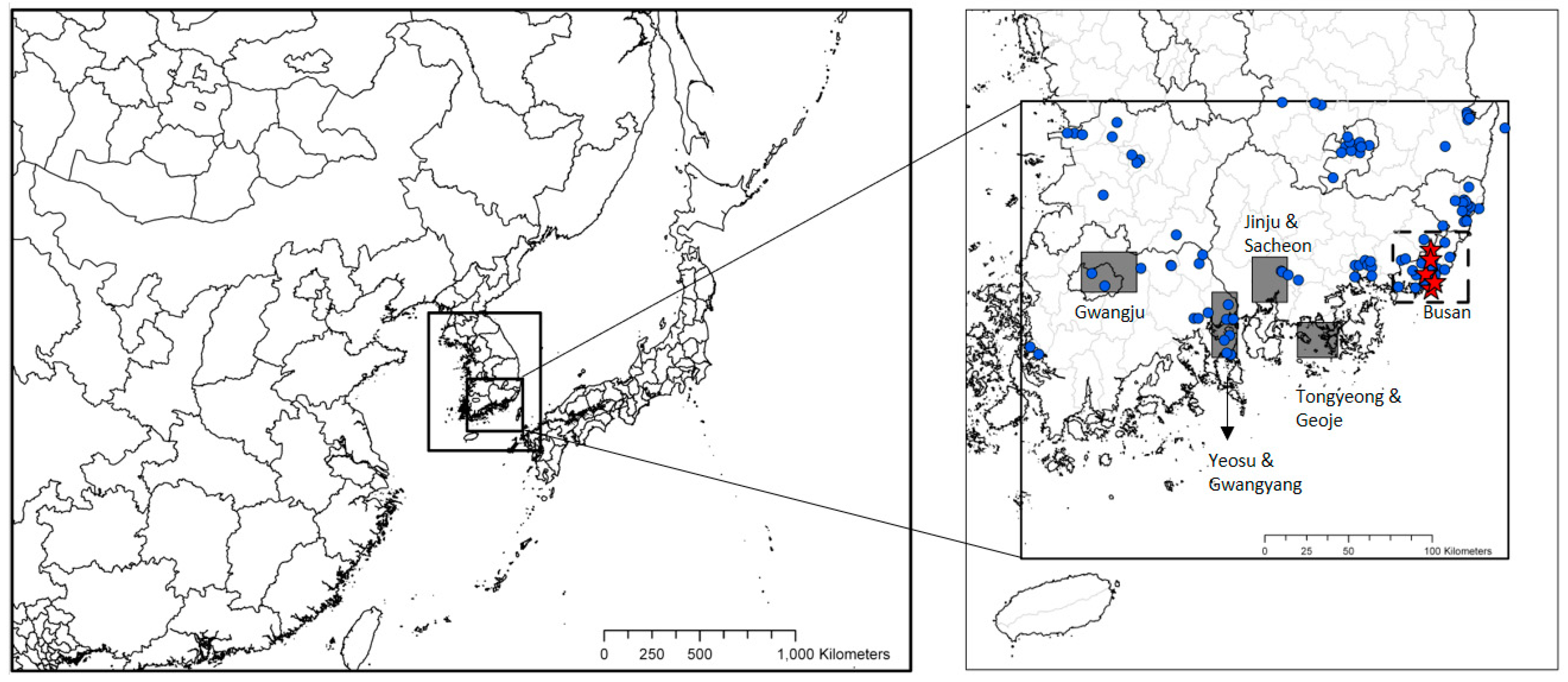




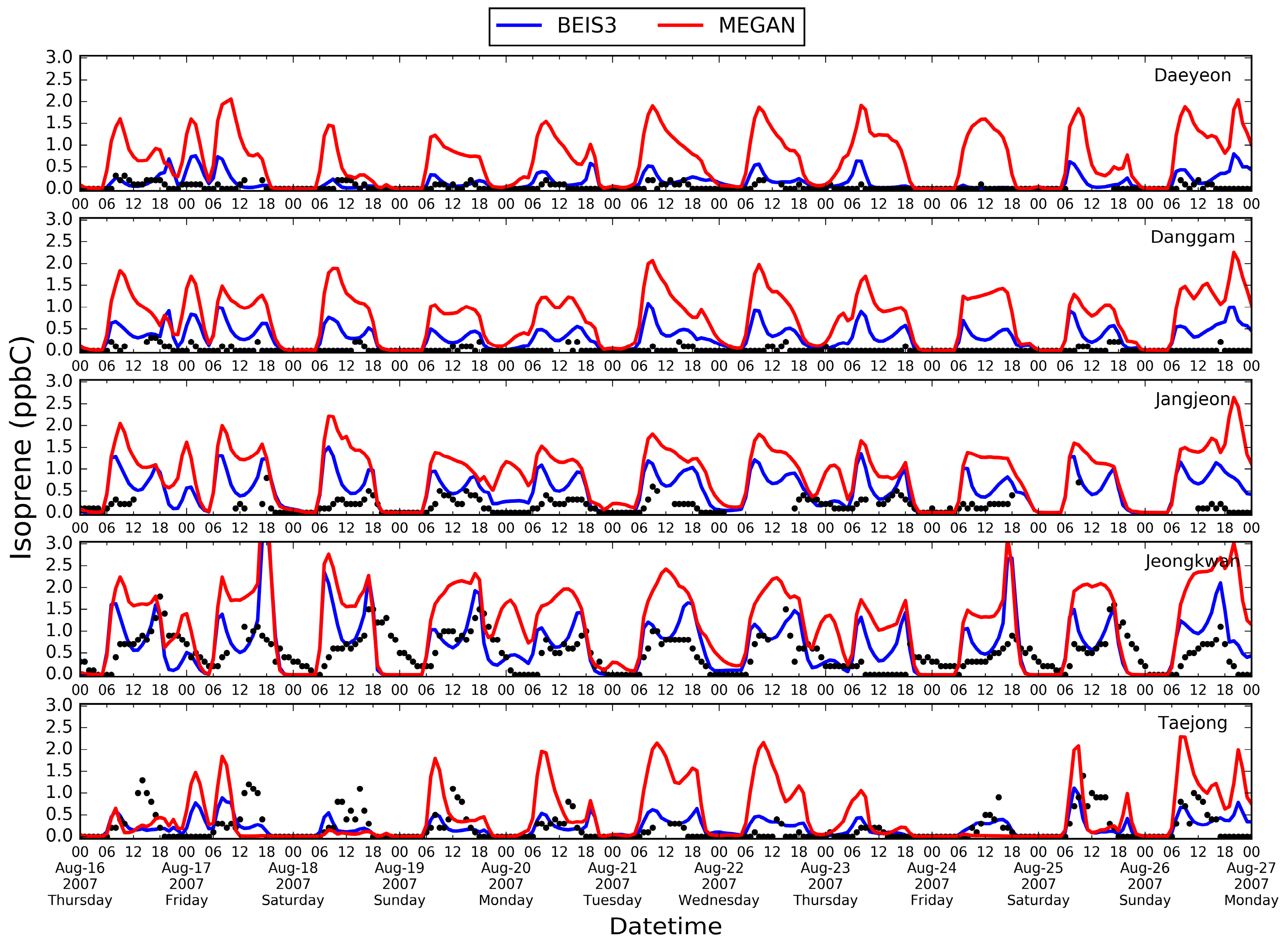

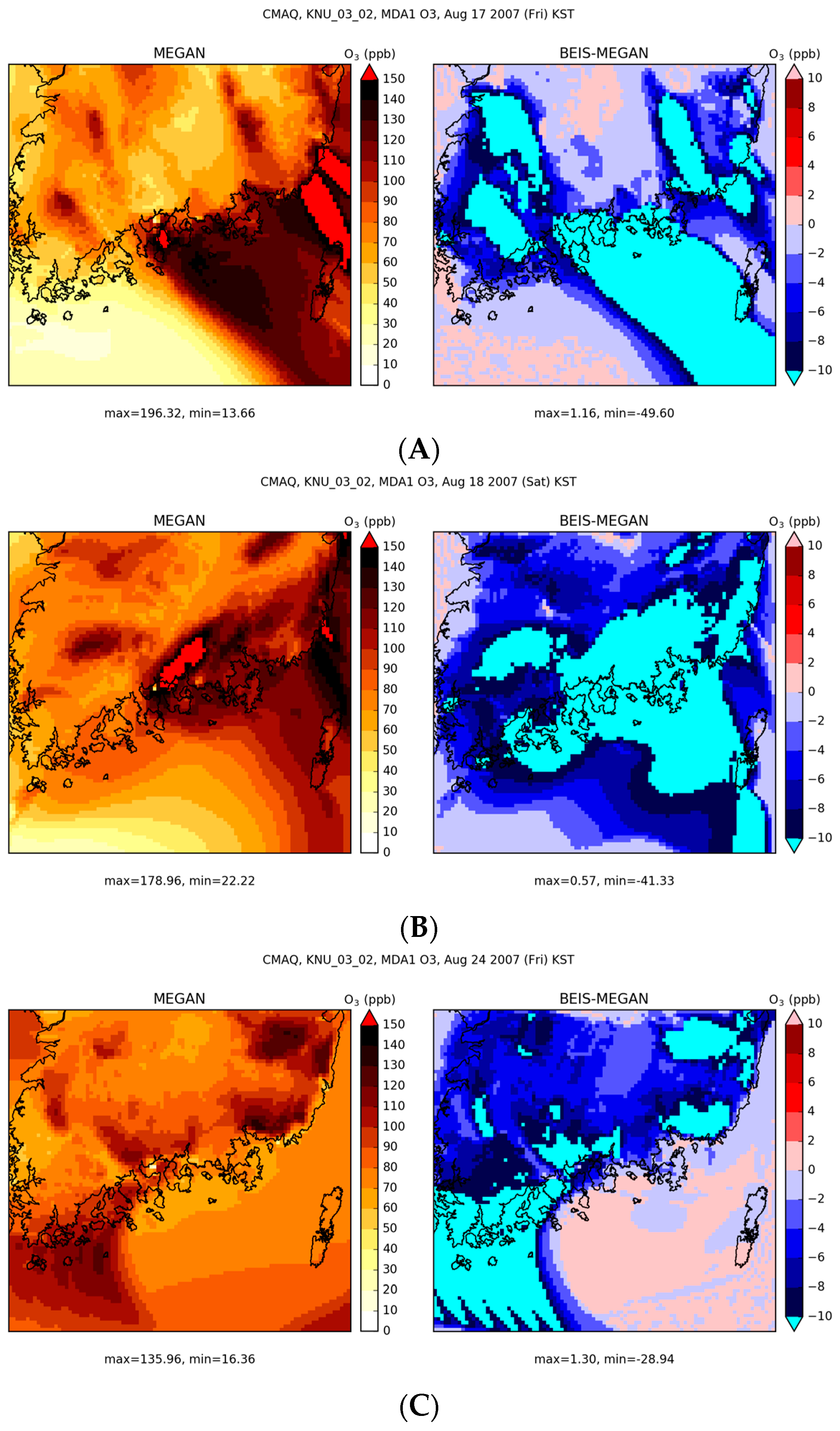

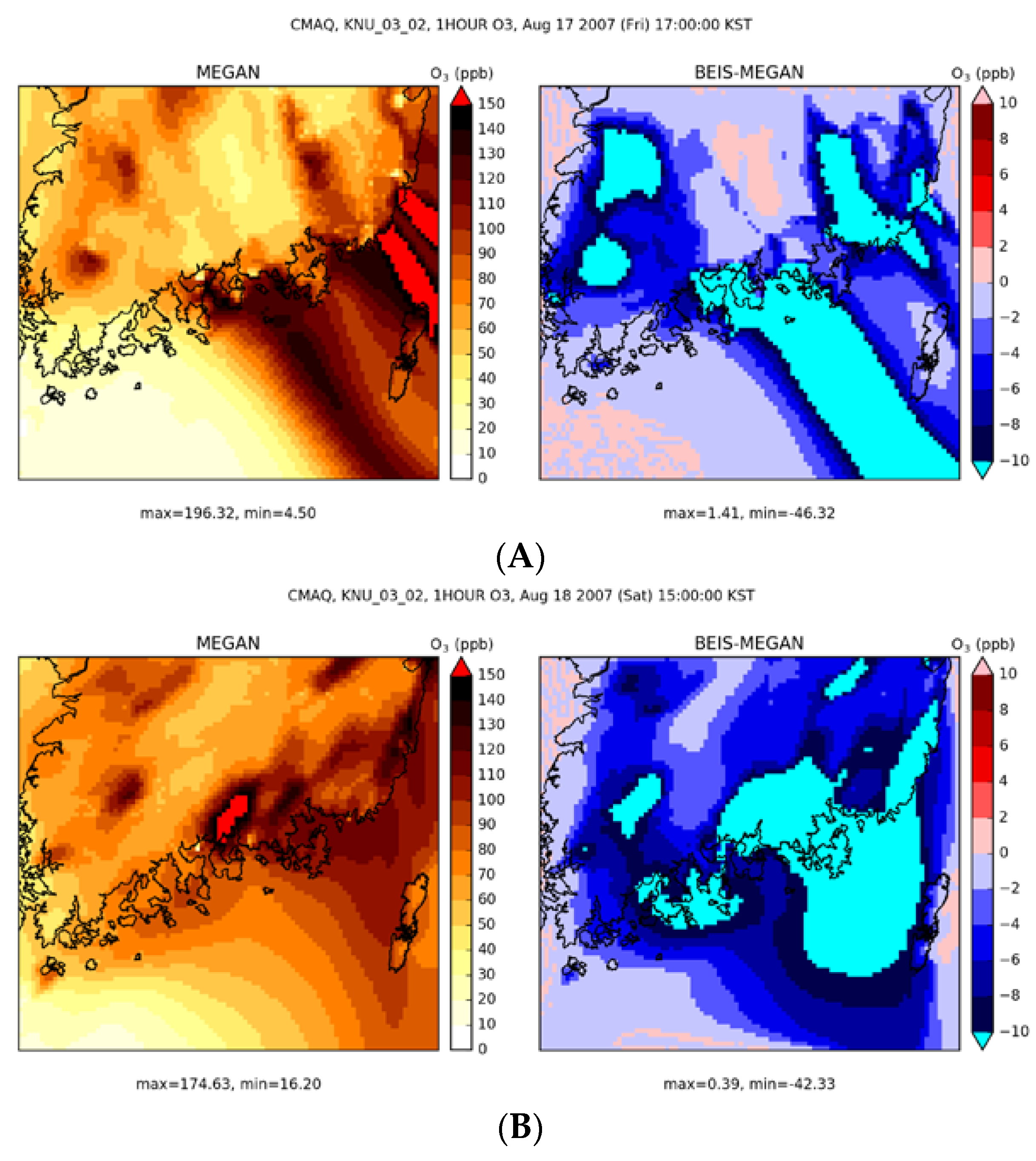
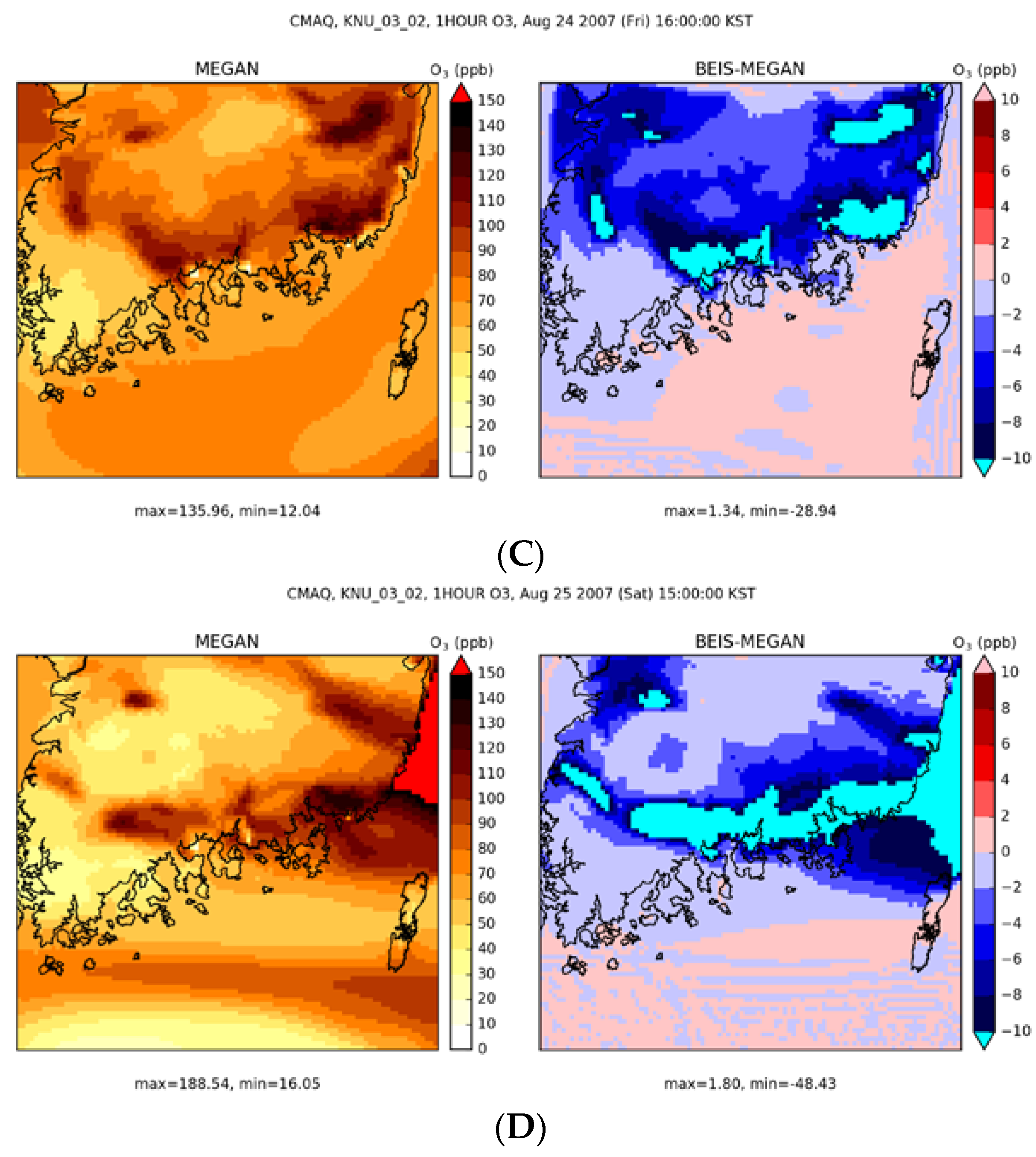
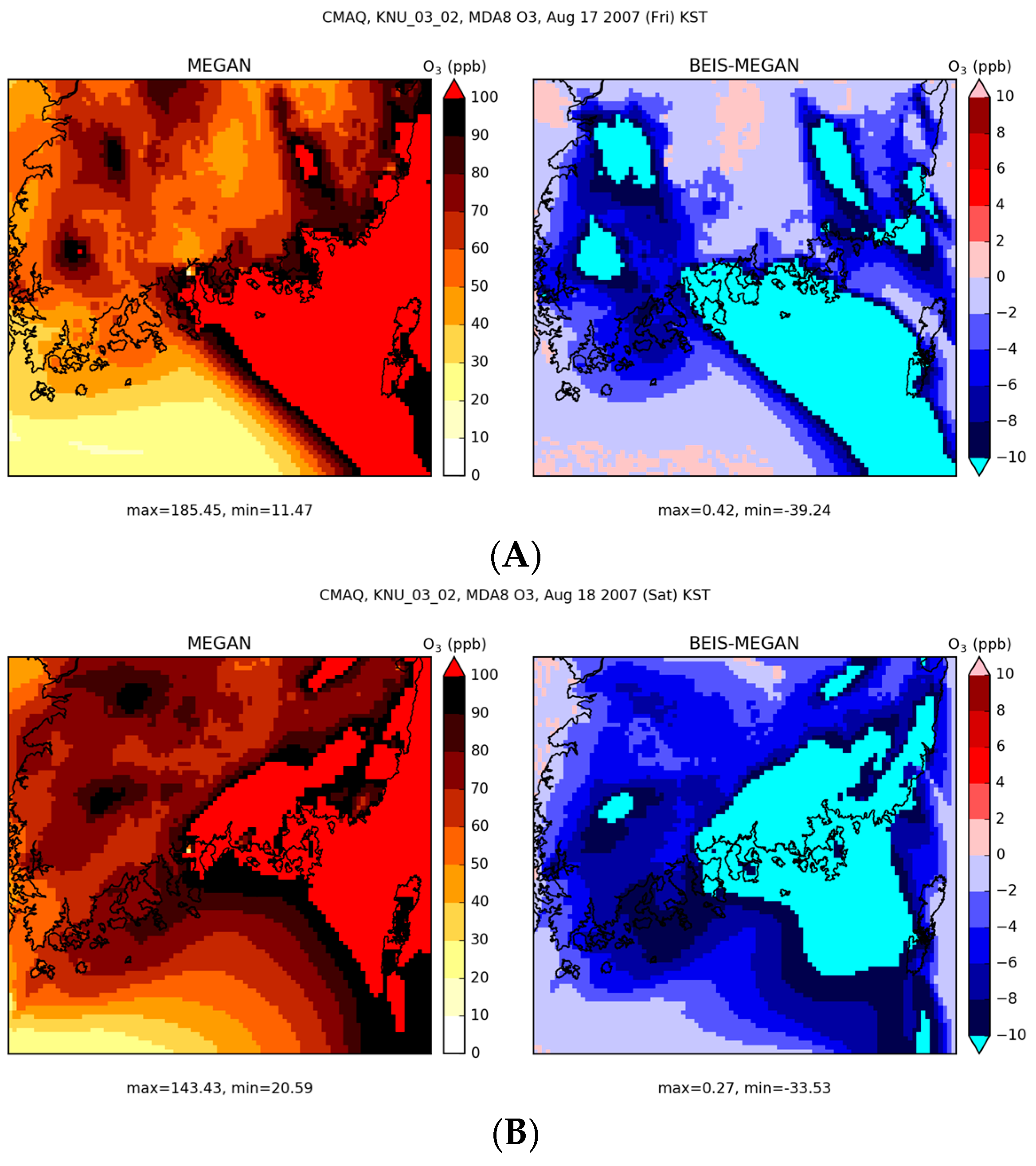
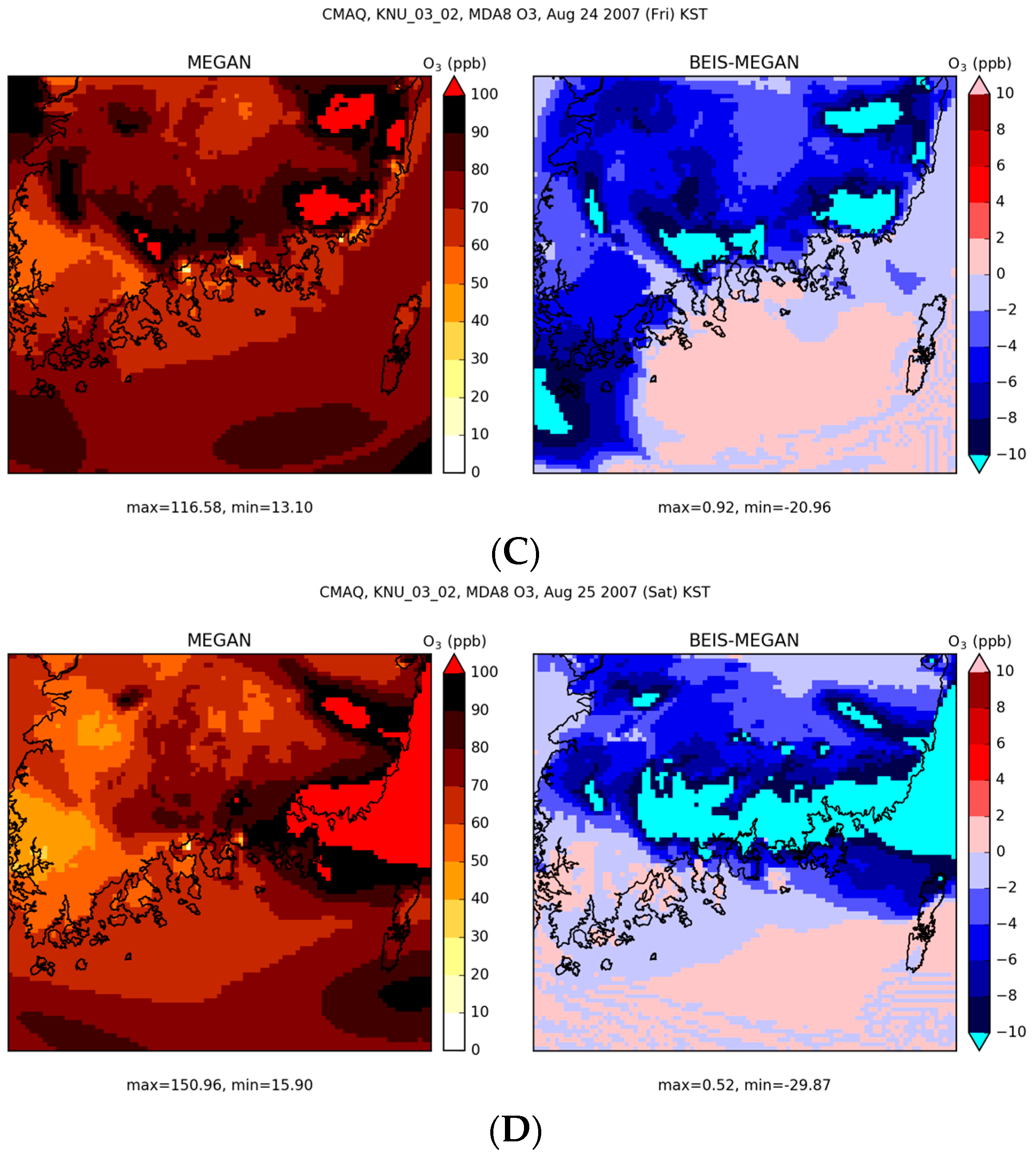
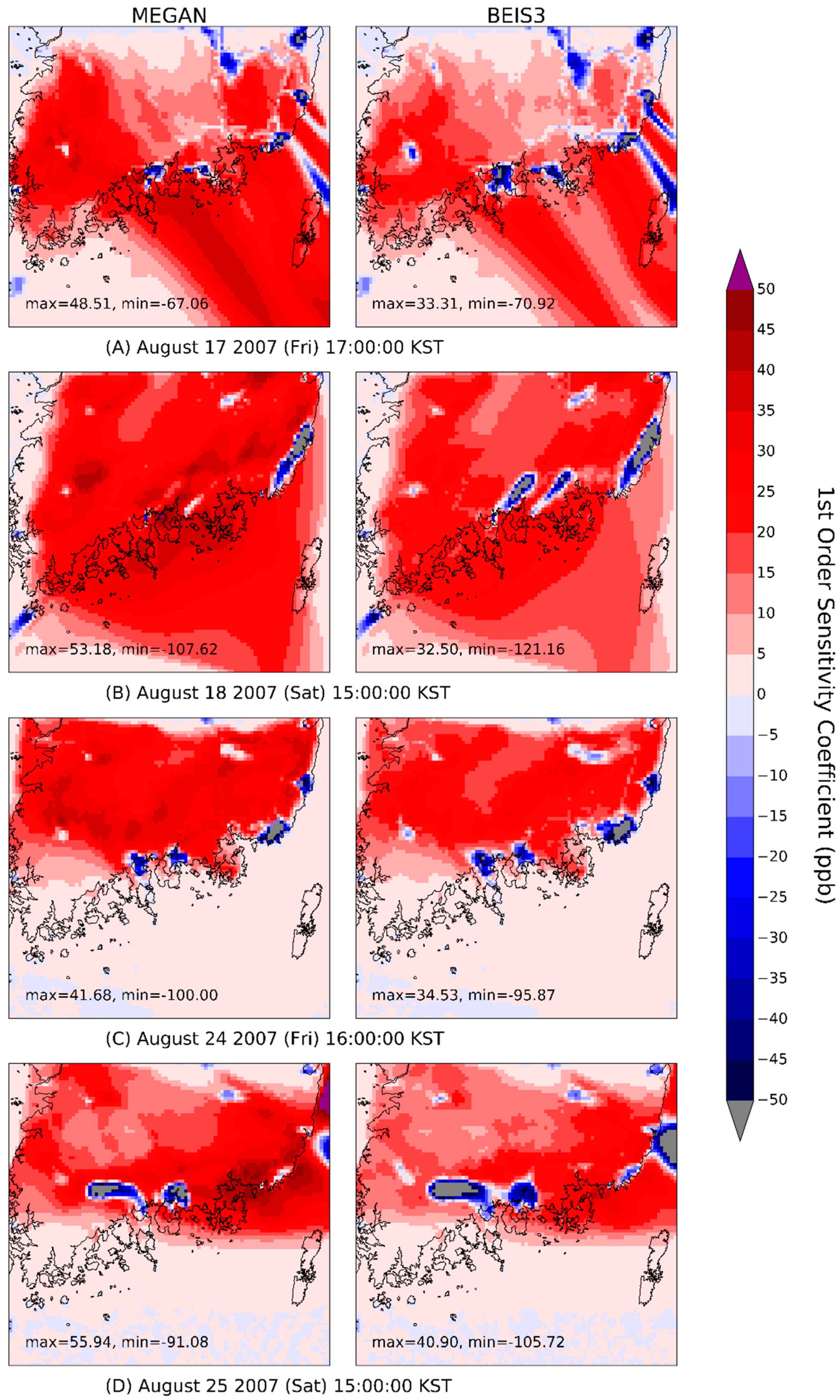
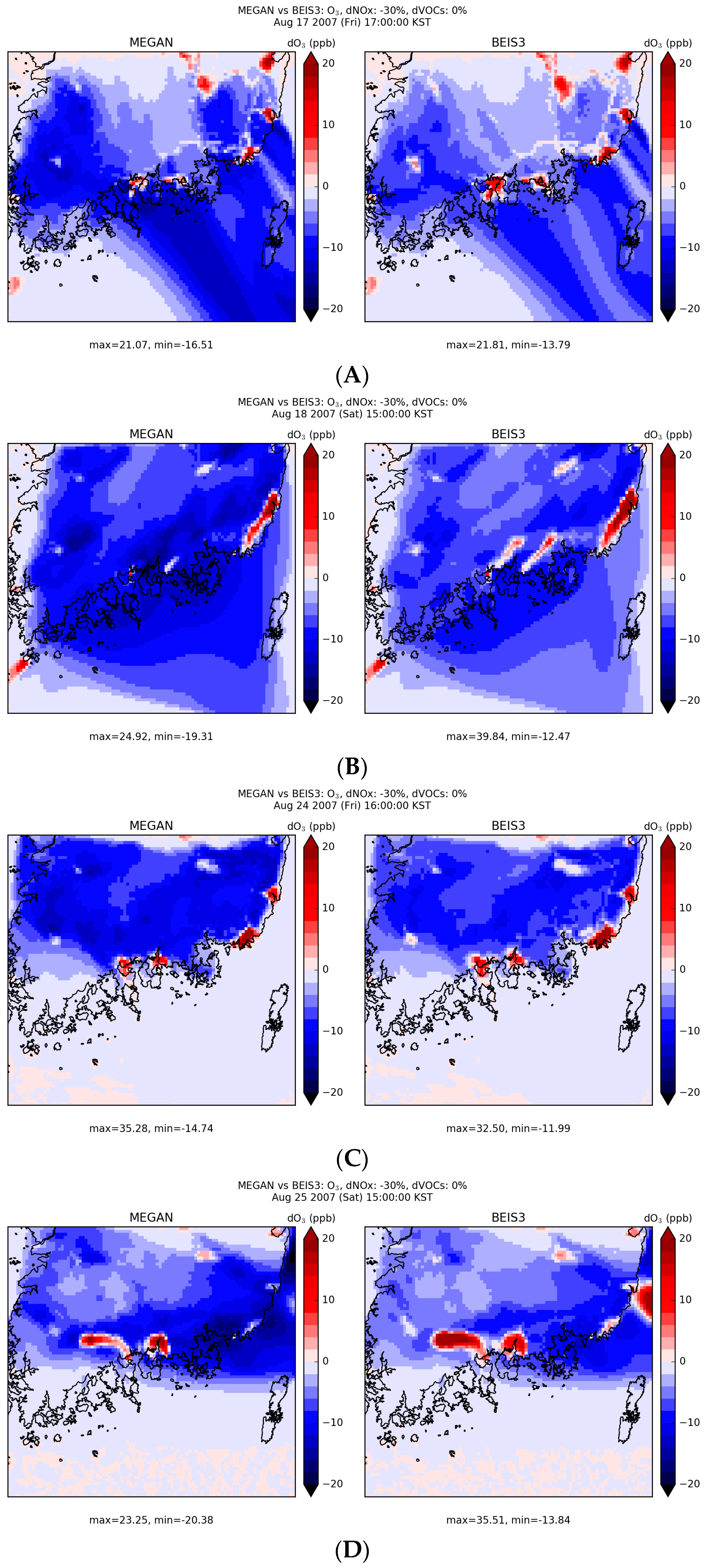

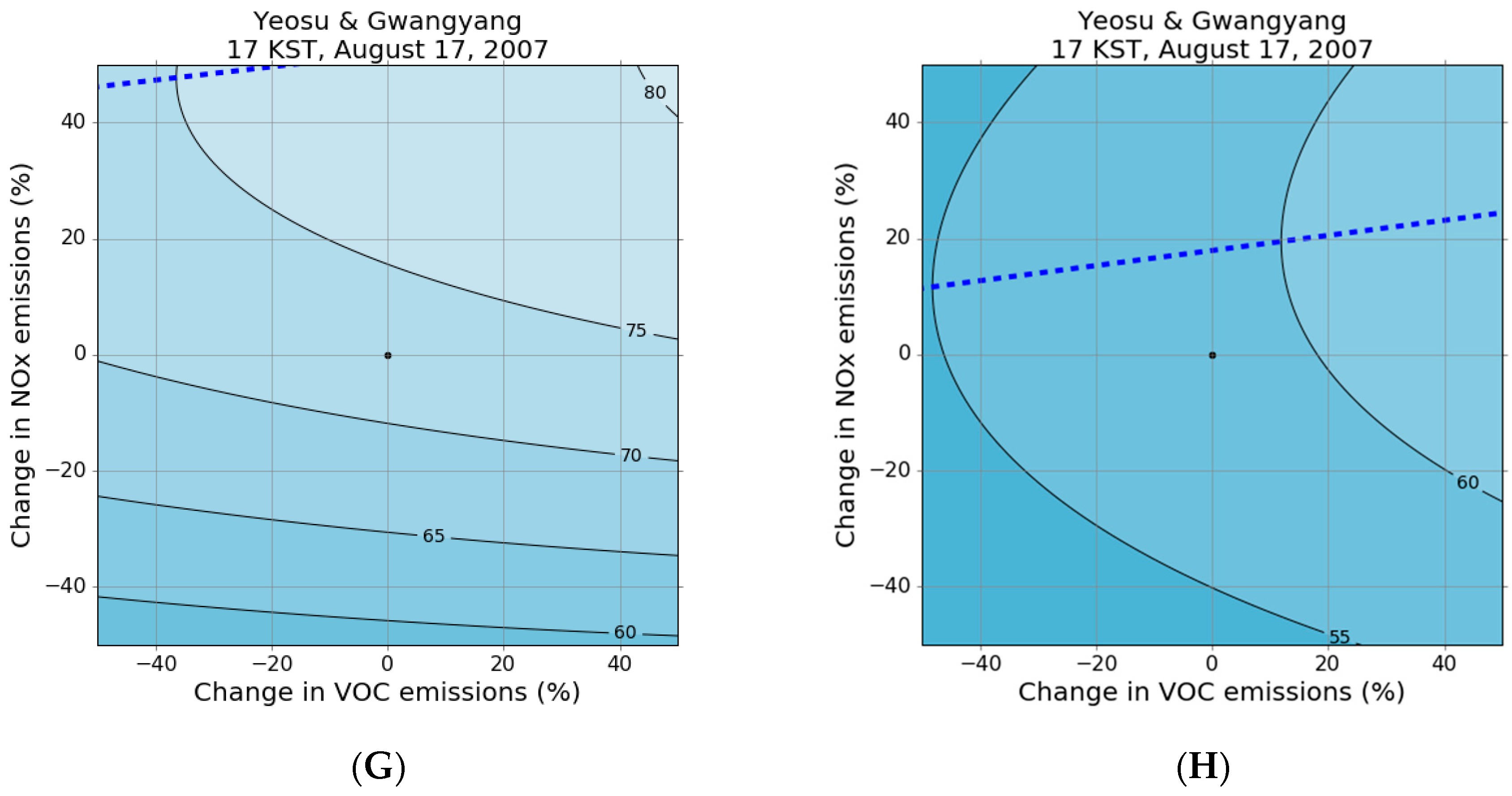
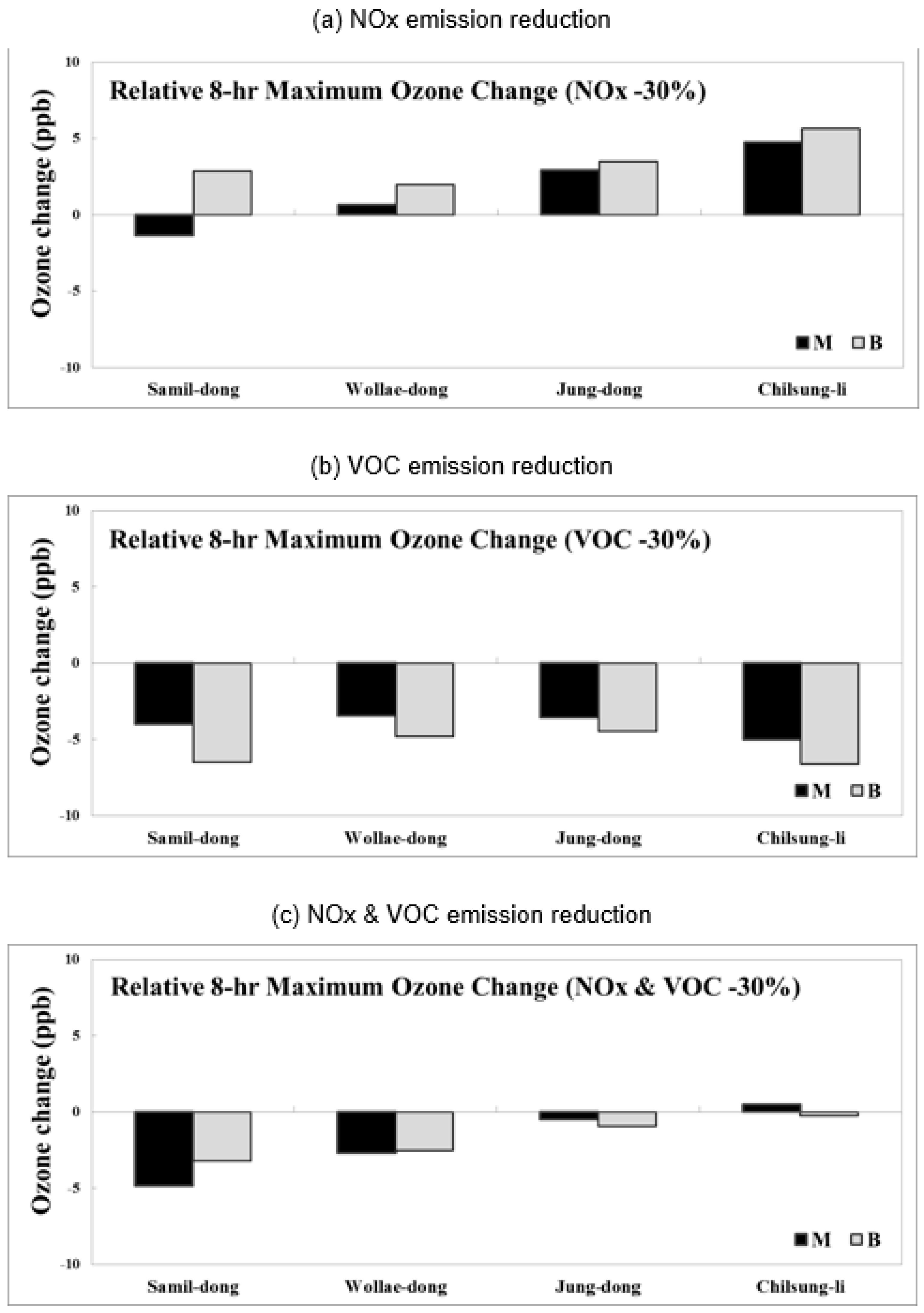
| Month of 2007 | Number of Monitor-Days When MDA1O3 > 100 ppb |
|---|---|
| March | 3 |
| April | 16 |
| May | 49 |
| June | 24 |
| July | 32 |
| August | 58 |
| September | 24 |
| October | 1 |
© 2017 by the authors. Licensee MDPI, Basel, Switzerland. This article is an open access article distributed under the terms and conditions of the Creative Commons Attribution (CC BY) license (http://creativecommons.org/licenses/by/4.0/).
Share and Cite
Kim, E.; Kim, B.-U.; Kim, H.C.; Kim, S. The Variability of Ozone Sensitivity to Anthropogenic Emissions with Biogenic Emissions Modeled by MEGAN and BEIS3. Atmosphere 2017, 8, 187. https://doi.org/10.3390/atmos8100187
Kim E, Kim B-U, Kim HC, Kim S. The Variability of Ozone Sensitivity to Anthropogenic Emissions with Biogenic Emissions Modeled by MEGAN and BEIS3. Atmosphere. 2017; 8(10):187. https://doi.org/10.3390/atmos8100187
Chicago/Turabian StyleKim, Eunhye, Byeong-Uk Kim, Hyun Cheol Kim, and Soontae Kim. 2017. "The Variability of Ozone Sensitivity to Anthropogenic Emissions with Biogenic Emissions Modeled by MEGAN and BEIS3" Atmosphere 8, no. 10: 187. https://doi.org/10.3390/atmos8100187





